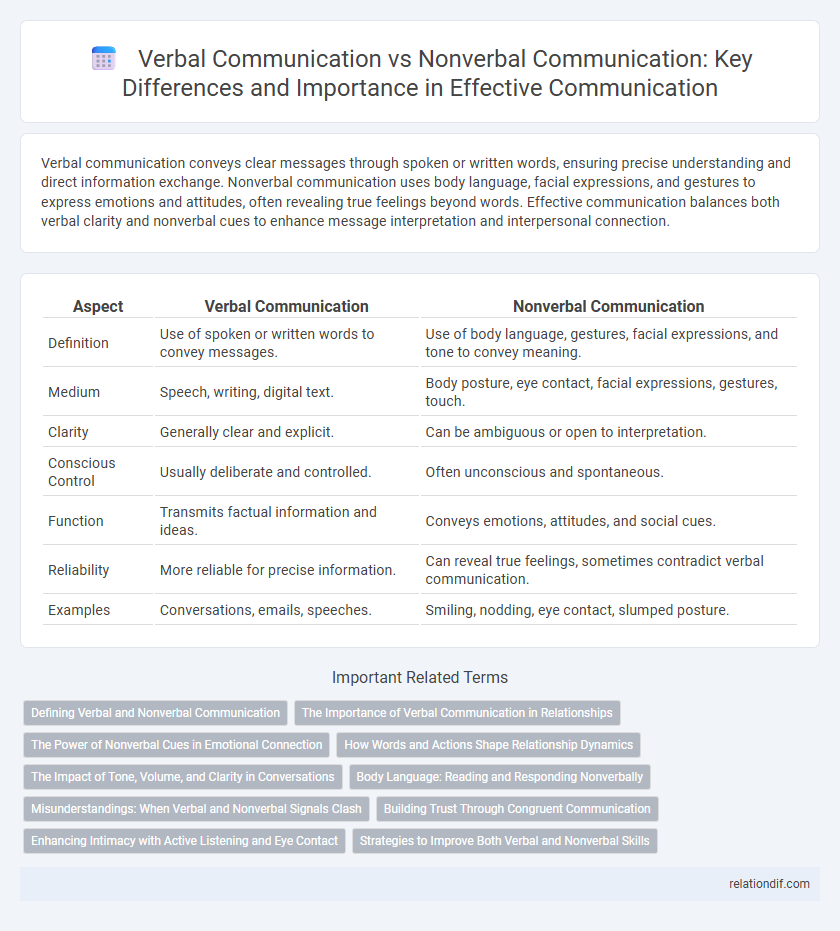Verbal communication conveys clear messages through spoken or written words, ensuring precise understanding and direct information exchange. Nonverbal communication uses body language, facial expressions, and gestures to express emotions and attitudes, often revealing true feelings beyond words. Effective communication balances both verbal clarity and nonverbal cues to enhance message interpretation and interpersonal connection.
Table of Comparison
| Aspect | Verbal Communication | Nonverbal Communication |
|---|---|---|
| Definition | Use of spoken or written words to convey messages. | Use of body language, gestures, facial expressions, and tone to convey meaning. |
| Medium | Speech, writing, digital text. | Body posture, eye contact, facial expressions, gestures, touch. |
| Clarity | Generally clear and explicit. | Can be ambiguous or open to interpretation. |
| Conscious Control | Usually deliberate and controlled. | Often unconscious and spontaneous. |
| Function | Transmits factual information and ideas. | Conveys emotions, attitudes, and social cues. |
| Reliability | More reliable for precise information. | Can reveal true feelings, sometimes contradict verbal communication. |
| Examples | Conversations, emails, speeches. | Smiling, nodding, eye contact, slumped posture. |
Defining Verbal and Nonverbal Communication
Verbal communication involves the use of spoken or written words to convey messages, relying on language, tone, and articulation to express ideas clearly. Nonverbal communication encompasses body language, facial expressions, gestures, posture, and eye contact, which often convey emotions and intentions without the use of words. Together, verbal and nonverbal communication form a comprehensive system for effective interpersonal interaction, enhancing understanding and connection between individuals.
The Importance of Verbal Communication in Relationships
Verbal communication plays a crucial role in relationships by enabling clear expression of thoughts, feelings, and intentions, which helps prevent misunderstandings. Effective use of language fosters trust and emotional intimacy, allowing partners to resolve conflicts and build stronger connections. In contrast, solely relying on nonverbal cues can lead to ambiguous interpretations and hinder meaningful dialogue.
The Power of Nonverbal Cues in Emotional Connection
Nonverbal communication conveys emotions through facial expressions, body language, and tone of voice, often revealing true feelings more effectively than words. Studies show that up to 93% of emotional meaning in interactions is transmitted nonverbally, emphasizing the critical role of gestures and eye contact in building trust and empathy. Mastering these cues enhances interpersonal connections by enabling deeper understanding beyond spoken language.
How Words and Actions Shape Relationship Dynamics
Verbal communication conveys explicit messages through spoken or written words, providing clarity and detail in relationships, while nonverbal communication, including facial expressions, body language, and tone of voice, conveys emotions and subtleties that often reveal true feelings. The interaction between words and actions creates a dynamic feedback loop that builds trust, expresses empathy, and influences relational intimacy. Misalignment between verbal messages and nonverbal cues can lead to misunderstandings and conflict, underscoring the importance of consistency in communication for healthy relationship dynamics.
The Impact of Tone, Volume, and Clarity in Conversations
Tone, volume, and clarity significantly influence the effectiveness of verbal communication by shaping how messages are perceived and understood. Nonverbal communication, such as facial expressions and body language, often reinforces or contradicts spoken words, impacting the overall interpretation. Together, these elements determine the emotional resonance and clarity of conversations, enhancing interpersonal connections and reducing misunderstandings.
Body Language: Reading and Responding Nonverbally
Body language plays a crucial role in nonverbal communication, conveying emotions and intentions through gestures, facial expressions, and posture. Understanding and accurately interpreting these signals enhances interpersonal interactions and helps avoid misunderstandings. Responding effectively to nonverbal cues improves communication by fostering empathy, trust, and clarity between individuals.
Misunderstandings: When Verbal and Nonverbal Signals Clash
Misunderstandings frequently arise when verbal communication conflicts with nonverbal signals, such as tone, facial expressions, or body language, creating ambiguity in the intended message. Studies in communication theory highlight that over 60% of meaning is conveyed nonverbally, emphasizing how discrepancies between spoken words and nonverbal cues lead to confusion and misinterpretation. Effective communicators must align verbal content with consistent nonverbal behavior to minimize misunderstandings and improve interpersonal clarity.
Building Trust Through Congruent Communication
Building trust hinges on congruent communication where verbal messages align seamlessly with nonverbal cues such as facial expressions, gestures, and tone of voice. Inconsistent signals between spoken words and body language often trigger skepticism, undermining trustworthiness. Effective communicators consistently synchronize verbal content with nonverbal behavior to foster authenticity and strengthen interpersonal relationships.
Enhancing Intimacy with Active Listening and Eye Contact
Active listening and sustained eye contact significantly deepen intimacy by fostering genuine connection and understanding in verbal communication. Nonverbal cues such as facial expressions and body language complement spoken words, reinforcing emotional bonds between individuals. Prioritizing these interactive elements enhances trust, empathy, and intimacy in personal and professional relationships.
Strategies to Improve Both Verbal and Nonverbal Skills
Effective communication requires mastering both verbal and nonverbal skills through targeted strategies such as active listening, clear articulation, and mindful body language. Enhancing verbal communication involves practicing concise messaging, using appropriate tone, and expanding vocabulary, while nonverbal skills improve with consistent eye contact, controlled facial expressions, and awareness of gestures. Integrating feedback mechanisms and role-playing exercises strengthens the synergy between spoken words and physical cues, leading to more impactful and authentic interactions.
verbal communication vs nonverbal communication Infographic

 relationdif.com
relationdif.com